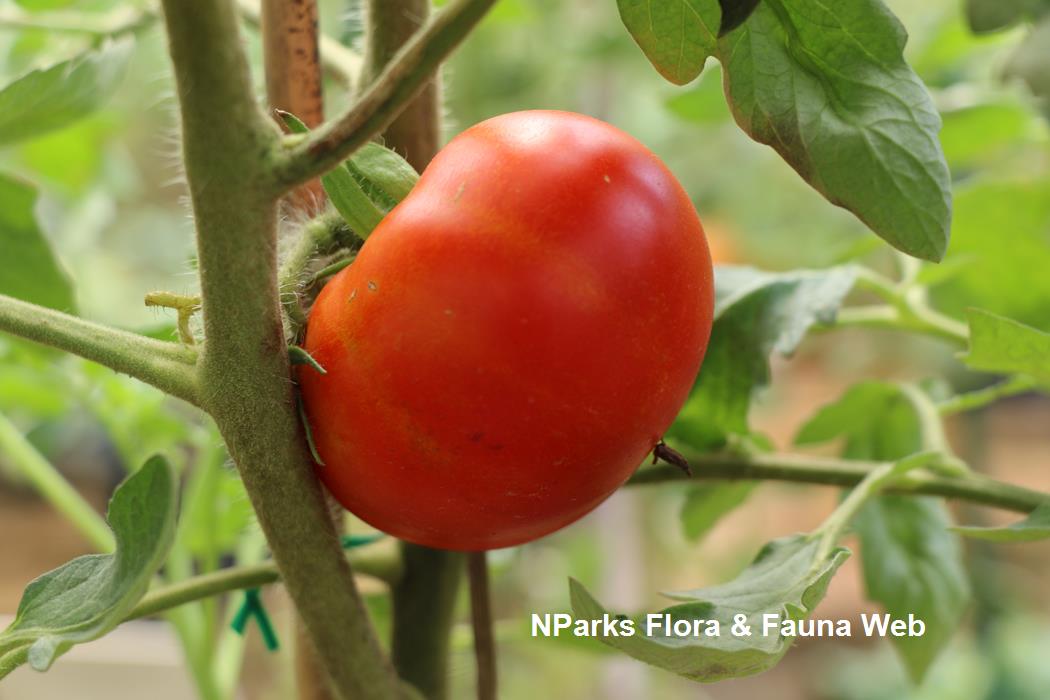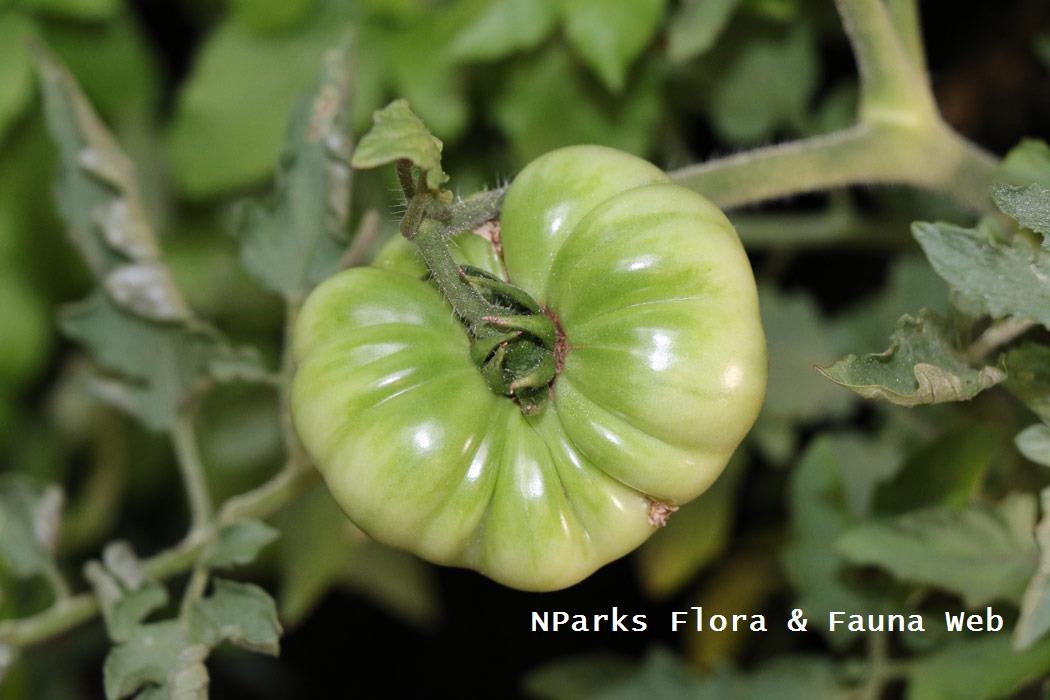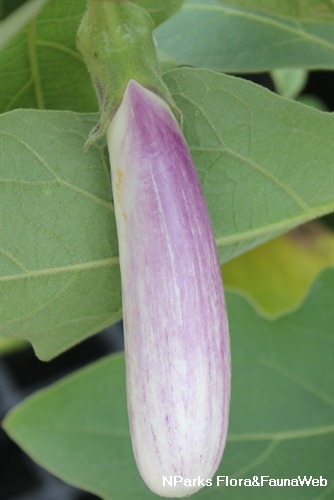
Back
Solanum lycopersicum L.
| Family Name: | Solanaceae |
| Synonyms: | Solanum esculentum |
| Common Name: | Tomato, 蕃茄, தக்காளி |
Name
Classifications and Characteristics
| Plant Division | Angiosperms (Flowering Seed Plants) (Dicotyledon) |
|---|---|
| Plant Growth Form | Herbaceous Plant |
| Lifespan (in Singapore) | Annual |
| Mode of Nutrition | Autotrophic |
Biogeography
| Native Distribution | Mexico and South America. |
|---|---|
| Native Habitat | Terrestrial |
| Preferred Climate Zone | Tropical, Sub-Tropical / Monsoonal, Highland / Montane |
Description and Ethnobotany
| Growth Form | It is an herb that can either be erect or trailing, growing up to 2m in height. The plant is usually pubescent with glandular hairs which cause the plant to feel sticky upon touch. |
|---|---|
| Foliage | Leaves are alternate, pinnately compound measuring between 0.8–1.2 × 0.6–0.7 cm. Each leaf has 2-8 pairs of leaflets, ovate to oblong in shape. They are deeply lobed with an irregular toothed margin. The petiole measures between 1.2-7cm long. Its leaves are also very aromatic. |
| Flowers | Flowers are borne in inflorescence on the axillary buds, hanging downwards. Flowers are yellow, bisexual, and self-fertile measuring between 0.4-1cm in length. The anthers bend into a cone-like structure, surrounding the stigma. |
| Fruit | Fruits are berries, shiny and smooth ranging between 1- 2cm in diameter. Once it ripens, the fruit turns from green to red. Fruit contains numerous kidney-shaped seeds covered in pulp. Seeds are yellow-grey, covered in long soft hairs measuring between 0.2 - 0.3mm in length. |
| Cultivation | It is best grown under full sun in well-drained, fertile, and moist soil. Plants should be staked to avoid the stems from drooping down due to their heavy fruits. Seeds may take 3- 5 days to germinate. The period from sowing to the first harvest of its fruits is about 77-105 days. It is a long-lived annual plant in the sense that it may live longer than 1 year in a frost-free climate, but its vigour declines after about a year. |
| Ethnobotanical Uses | Edible Plant Parts : Edible Fruits Food (Fruit or Vegetable): Tomato is botanically a berry, it is considered a vegetable for culinary purposes.The fruit is consumed in many ways, including raw in salads, processed into ketchup, and tomato juice is sold as a drinks. Medicinal: Tomatoes have been used traditionally to treat several ailments. The fruit has very good nutritive value as it is fairly rich in vitamin C, and other minerals. Tomato consumption can help to lower blood pressure and the risk of heart disease. Fresh juice are used to stop excessive bleeding from wounds. In Italy, it is used to cure scorpion and other insect bites. In Philippines, the fresh fruit is used to treat edema by pregnant woman. |
Landscaping Features
| Landscape Uses | General, Parks & Gardens, Small Gardens |
|---|---|
| Thematic Landscaping | Economic Garden |
Fauna, Pollination and Dispersal
| Pollination Method(s) | Biotic (Fauna) (Insects (Bee)), Abiotic (Self-Pollinated) |
|---|
Plant Care and Propagation
| Light Preference | Full Sun |
|---|---|
| Water Preference | Moderate Water, [Remarks] (The soil should be kept moist, not waterlogged. ) |
| Plant Growth Rate | Fast |
| Rootzone Tolerance | Moist Soils, Well-Drained Soils, Fertile Loamy Soils |
| Potential Problems | Check the underside of leaves regularly for aphids, whiteflies and red spider mites. Avoid over-fertilising which encourages aphids to attack. Adult whiteflies can be trapped by hanging yellow sticky traps. Control red spider mites by applying organic soap or mineral oil to the leaves. Check the soil for root-knot nematodes. Crop rotation with resistant varieties or non-host plants may help to control them. |
| Diseases | Aphids and whiteflies produce sweet, sticky excrement which attracts sooty mould. |
| Pest(s) | Sucking Insects, Nematodes |
| Propagation Method | Seed |
| Propagation Method Remarks | To avoid a decline in seed viability, remove the seeds from the ripe fruit as soon possible before allowing the seeds to dry in room temperature. |
| Seed / Spore Germination Duration | 6 days |
Foliar
| Foliage Retention | Evergreen |
|---|---|
| Mature Foliage Colour(s) | Green |
| Mature Foliage Texture(s) | Velvety / Furry / Tomentose |
| Foliar Type | Compound |
| Foliar Arrangement Along Stem | Alternate |
| Foliar Attachment to Stem | Petiolate |
| Foliar Margin | Serrate / Toothed, Dentate, Pinnately Lobed / Pinnatifid, Irregularly Incised |
| Foliar Apex - Tip | Obtuse |
| Foliar Base | Cuneate, Oblique / Asymmetrical |
Floral (Angiosperm)
| Flower & Plant Sexuality | Bisexual Flowers |
| Flower Colour(s) | Yellow / Golden |
|---|---|
| Flower Grouping | Solitary, Cluster / Inflorescence |
| Inflorescence Type | Raceme, Cyme |
Fruit, Seed and Spore
| Mature Fruit Colour(s) | Red |
|---|---|
| Mature Fruit Texture(s) | Smooth, Glossy / Shiny |
| Fruit Type | Fleshy Fruit , Non-Accessory Fruit |
| Seed Quantity Per Fruit | Several (11-20) |
Image Repository
Others
| Master ID | 31375 |
|---|---|
| Species ID | 5772 |
| Flora Disclaimer | The information in this website has been compiled from reliable sources, such as reference works on medicinal plants. It is not a substitute for medical advice or treatment and NParks does not purport to provide any medical advice. Readers should always consult his/her physician before using or consuming a plant for medicinal purposes. |





.jpg)
.jpg)
.jpg)
.jpg)




